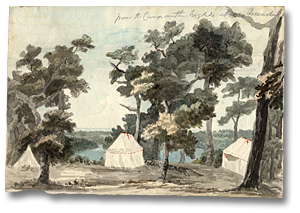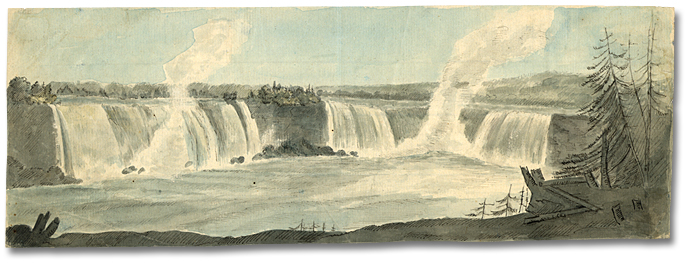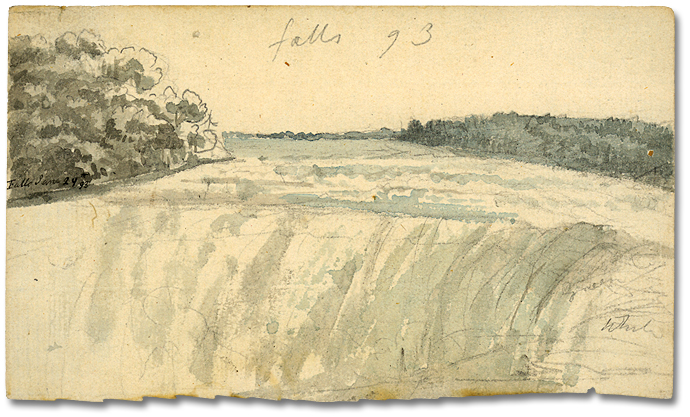
Navy Hall and Niagara Falls
Navy Hall
![Watercolour: Navy Hall, the part is the canvas house b) The fort at Niagara c) A large arbour in the HiIl d) Toronto Shore, [ca. 1793] (detail)](pics/6951-300.jpg)
Click to see a larger version (122K)
Navy Hall, the part is the canvas house b) The
fort at Niagara c) A large arbour in the HiIl d)
Toronto Shore, [ca. 1793] (detail)
Elizabeth Simcoe, (1766-1850)
Wash/paper
Reference Code: F 47-11-1-0-99
Archives of Ontario, I0006951
The Simcoes docked at Navy Hall in Newark (Niagara on the Lake) on July 26th, 1792.
Navy Hall, part of a group of buildings which stood on the edge of the Niagara River, was used by British commanders who travelled to Lake Ontario.
It served to supply military vessels which cruised to the western part of the lake.
The first legislature was held at Navy Hall on September 17th 1792.
|
“Navy Hall is a House built by the Navel Commanders on this Lake for their reception when here - it is now undergoing a thorough repair for our occupation but is still to unfinished that the Gov'r has ordered, 3 marquees to be pitched for us on the Hill above the House which is very dry ground & Rises beautifully, in parts covered with oak bushes...” - July 26th, 1792 |

Click to see a larger version (177K)
From the Camps on the heights
above Queenstown, July 9, 1793 (detail)
Elizabeth Simcoe, (1766-1850)
Wash/paper
Reference Code: F 47-11-1-0-90
Archives of Ontario, I0006942
The Falls
On Wednesday July 25th, 1792 Elizabeth had her first view of the spray from the Niagara Falls.
|
“A clear cold day, made little way, a head wind. I saw the spray of the Falls of Niagara rising like a cloud. It is 40 miles distant.” - July 25, 1792 |
|
“...the fall is said to be but 170 feet in height, the River previously rushes in the most rapid manner on a declivity for 3 miles & those rapids are a very fine sight - the fall itself is the grandest sight imaginable from the immense width of waters & the circular form of the grand fall...the whole center of the fall.. is frequently seen a Rainbow.” - July 30th, 1792 |
![Watercolour: Chippiwa - The spray of Niagara Falls, [ca. 1795] (detail)](pics/6350-300.jpg)
Click to see a larger version (141K)
Chippiwa - The spray of Niagara Falls, [ca. 1795] (detail)
Elizabeth Simcoe, (1766-1850)
Wash/paper
Reference Code: F 47-11-1-0-165
Archives of Ontario, I0006350

Click to see a larger version (85K)
Niagara Falls, Ontario, July 30, 1792, (detail)
Elizabeth Simcoe, (1766-1850)
Watercolour paper
Reference Code: F 47-11-1-0-71
Archives of Ontario, I0006923
|
“I descended an exceedingly steep hill to get to the Table Rock, from whence the view of the Falls is tremendously fine. Men sometimes descend the rocks below this projecting point, but it is attended with great difficulty and perhaps little picturesque advantage.
- August 3, 1792 Click here to listen to a recording of the quote in wav format (417K) |
|
“...vast rocks surround this bend of the River & they are covered with Pine & hemlock spruce, some Cascades among the Rocks add to the wild appearance these scenes have afforded me so much delight that I class these days with those in which I remember to have felt the greatest pleasure from fine objects whether of art or Nature...” - March 23rd, 1793 |
|
“I rode to the whirlpool, a very grand Scene half way between Queenstown & the Falls, where the current is so strong that Eddies are formed in which hewn timber trees are carried ” - April 23rd, 1793 |
![Watercolour: [Niagara Falls], [between 1791 and 1796] (detail)](pics/7026-300.jpg)
Click to see a larger version (136K)
[Niagara Falls], [between 1791 and 1796] (detail)
Elizabeth Simcoe, (1766-1850)
Watercolour paper
Reference Code: F 47-11-1-0-174
Archives of Ontario, I0007026
|
“People cross from Chippawa to Fort Schlosser (an earthwork fort on the American shore, about a mile and a half above the Falls), but great caution is necessary, the current is so extremely strong and if they did not make exactly the mouth of the Chippawa the force of the water below it would inevitably carry them down the Falls without redress. Eight soldiers, who were intoxicated, met with this accident in crossing the river some years since. Their bodies were taken up entire some distance below the Falls. An Indian was in his canoe near Fort Schlosser. The canoe was tied to a tree; some person cut the rope; he did not wake until the canoe had gotten into the strong current. He found all his endeavours to paddle ineffectual and was seen to lay himself down, resigning himself to his fate, and was soon carried down the falls.” - July 30th, 1792 |

Click to see a larger version (130K)
View of the falls, June 29, 1793, (detail)
Elizabeth Simcoe, (1766-1850)
Watercolour paper
Reference Code: F 47-11-1-0-97
Archives of Ontario, I0006949
The Simcoes wintered over in Newark where Elizabeth gave birth to a daughter, Katherine, in mid January, 1793. Writing to a friend who was caring for the Simcoes' four eldest children in England, Elizabeth painted a happy picture of her life in Upper Canada.
|
“The whole winter has been like an exceedingly fine, dry autumn in England; the climate is delightful and the country plentiful, and a pleasant society within a certain circle; in short, we have nothing to complain of but not seeing the children and the absence of some friends.” - Navy Hall, February 1793 |
Elizabeth Simcoe - The Early Years | Sailing for the Canadas | Winter in Quebec City
Kingston and the Thousand Islands | Navy Hall and Niagara Falls | Travels Around the Niagara Peninsula
The Trip to York | Return to Niagara | Return to Quebec | The Final Year
Going Home to England | The Simcoe Collection | About Elizabeth's Diaries | John Graves Simcoe
Significant Events in the Early History of Canada | Acknowledgements and Sources